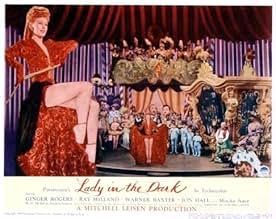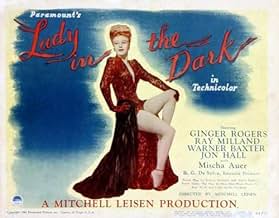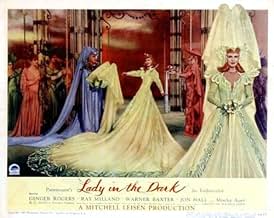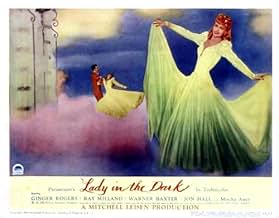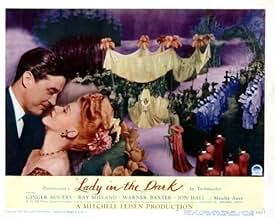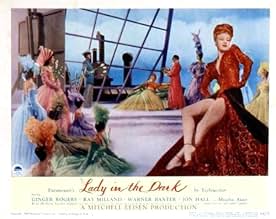VALUTAZIONE IMDb
5,9/10
610
LA TUA VALUTAZIONE
Aggiungi una trama nella tua linguaLiza Elliott, "Allure" magazines editor-in-chief, suffers from headaches and continuous daydreams and undergoes psychoanalysis to determine why.Liza Elliott, "Allure" magazines editor-in-chief, suffers from headaches and continuous daydreams and undergoes psychoanalysis to determine why.Liza Elliott, "Allure" magazines editor-in-chief, suffers from headaches and continuous daydreams and undergoes psychoanalysis to determine why.
- Regia
- Sceneggiatura
- Star
- Candidato a 3 Oscar
- 1 vittoria e 3 candidature totali
Recensioni in evidenza
I like this movie. It is confusing and difficult, but you can't help but like it. Ginger Rogers plays a fashion magazine editor...and she finds herself having headaches and feeling dissatisfied. This makes no sense, as she has an exceptional job (especially for 1940) three suitors, and conscious and unconscious lives that are fabulously costumed. She goes to her doctor who recommends a psychiatrist...a drastic move for the time...which she promptly declines...but then does finally go to. Ginger undergoes a great deal of stress in this film,and keeping a bottle of aspirin at hand might be wise. As she makes progress with her shrink...her dream sequences become more and more lavish. The film is beautifully costumed...even clothes left lying on a chair...are fabulous. And there are HATS. HATS. Hats... mousey through military...lots of hats...and FURS...Ginger has one dress with a floor length mink skirt...lined with gold and scarlet sequins, two or three fur coats, a muff, and several other dresses trimmed with fur. Pull the shades and make certain that no one from PETA is around when you run this film. The dream sequences are the real meat of this...they are very beautiful and very surreal. In the end, of course, Ginger selects one of the men (no, not the married one) and seems to be on the road to recovery. You get the feeling that a lot got left out...and I don't know what (yet). I know Danny Kaye was 'discovered' in the Broadway show...and that he had special material. Danny was under contract to Sam Goldwyn by the time this was made...so neither he nor any of his special material made the transition into this film. This film is a visual knock out...and a restored print should be made and hi-def DVD's struck...so we can watch this from time to time. It cannot help but remain dated and politically incorrect....that is the legacy of its 1940 dateline.. but it will certainly always be stunning to look at.
I won't criticize much because I really like everything that Ginger Rogers does, yet somehow I get the feeling about this film, "there should have been more." At least I think more could have been done with the story.
Also, it brings to mind her later film, "It had to be You" which is a similar, comedic journey into the subconscious layers of the mind, obviously a popular topic of the day.
Ray Milland is in fine form here and I consider it one of his best roles.
The scenes are beautifully presented, very stagey at times with actors seemingly going through the motions, but the artistry of the settings and gowns is impeccable. All in all it's meant as light entertainment and ought to be viewed in that manner. Wish the video was available too.
Also, it brings to mind her later film, "It had to be You" which is a similar, comedic journey into the subconscious layers of the mind, obviously a popular topic of the day.
Ray Milland is in fine form here and I consider it one of his best roles.
The scenes are beautifully presented, very stagey at times with actors seemingly going through the motions, but the artistry of the settings and gowns is impeccable. All in all it's meant as light entertainment and ought to be viewed in that manner. Wish the video was available too.
"Lady in the Dark" from 1944 is an adaptation of the Broadway musical of the same name, which starred Gertrude Lawrence and made a star out of Danny Kaye. Mischa Auer, Jon Hall, Ray Milland, and Gail Russell. Auer is in Kaye's role, and his show-stopping number, "Tchaikovsky" was cut.
Actually, the music in this version is incidental to the film. Ginger Rogers plays Liza, the editor of a fashion magazine. She sees a doctor because of headaches and inability to concentrate. He sends her to a psychiatrist (Barry Sullivan).
Psychology and psychiatry really hit their stride during World War II for obvious reasons. Though "Lady in the Dark" is dated in its views toward women, the unraveling of Liza's psyche through musical dreams is very entertaining.
Ginger Rogers is spectacular - a beautiful actress and dancer, she radiates light in her gorgeous gowns, which belie her normal non-dream office attire. She gives a touching performance of a conflicted, unhappy woman who can't embrace life but doesn't understand why.
Ray Milland is charming and funny as Charley, Liza's office nemesis, and Mischa Auer as the temperamental photographer is excellent. Jon Hall and Warner Baxter are very good, but their characters don't have the development of the other roles.
Probably the 1954 Lady in the Dark starring Ann Sothern is better and truer to the show. This Lady is worth seeing for Ginger.
Actually, the music in this version is incidental to the film. Ginger Rogers plays Liza, the editor of a fashion magazine. She sees a doctor because of headaches and inability to concentrate. He sends her to a psychiatrist (Barry Sullivan).
Psychology and psychiatry really hit their stride during World War II for obvious reasons. Though "Lady in the Dark" is dated in its views toward women, the unraveling of Liza's psyche through musical dreams is very entertaining.
Ginger Rogers is spectacular - a beautiful actress and dancer, she radiates light in her gorgeous gowns, which belie her normal non-dream office attire. She gives a touching performance of a conflicted, unhappy woman who can't embrace life but doesn't understand why.
Ray Milland is charming and funny as Charley, Liza's office nemesis, and Mischa Auer as the temperamental photographer is excellent. Jon Hall and Warner Baxter are very good, but their characters don't have the development of the other roles.
Probably the 1954 Lady in the Dark starring Ann Sothern is better and truer to the show. This Lady is worth seeing for Ginger.
"Lady in the Dark" is a curiosity. The circus sequence with "The Saga of Jenny" gives a taste of what the movie version of the Broadway show might have been like (as other commentators have noted, the song is the sole survivor of the Broadway score by Weill and Gershwin, aside from snatches of "My Ship" and "Suddenly it's Spring", and a verse from "Once Life to Life" which Ginger Rogers recites). Ginger is a knockout, even in her "plain" business suits. The visual design is so rich you could swim in it- it was lovely to see the 40s magazine design as well as the sets. And the costumes! The sequin lined mink skirt is stunning, and so is the gown in the wedding sequence. The psychoanalysis storyline is well handled for a movie made in this period when analysis was strange and frightening to the audience. However, what could have been an exquisite soufflé is let down by the bizarre decision to cut all but one of the numbers and the development of the plot. It suggests that women are miserable in business suits and are far happier wearing frou frou gowns and being "dominated" by men (its terminology, not mine). I will say in the plot's defense (if I may take Ray Milland's part in the circus sequence for a moment) that it doesn't have Ginger pairing off with irresistible but insecure movie star Randy Curtis. When she announced that she was going to marry him and give up her job I yelled out, "You'll be sorry!" The writers recognize that Randy and staying home to be a housewife (even a Hollywood one) would bore Ginger's character out of her tree. Her sparring colleague is a far better choice, and there's a hint in the final that perhaps neither Ray or Ginger will dominate the other, but be partners in running the magazine (they're both overwhelmed with enthusiasm for it). But this hint of equality isn't enough to redeem Ray's earlier nastiness to Ginger, or the tone of misogyny. The movie still comes down with a thud, like Ginger at the end when Ray takes her chair.
The lady is in the 'dark' about being a lesbian. Oh why can't somebody just say it. I guess you could on Broadway and with Gertrude Lawrence in 1940 but at Paramount in '44 with Ginger, well, she just had to stay in the dark and have repressed sexual dreams about her fur in a cage and her eggs at a circus (see the Jenny number) ... and see that dress she unfurls.. a vagina representation of ever I saw one on a movie screen that wasn't x rated. In this ultra glamorous dreamy musical film Ginger is a business woman in business attire (read: lesbian .....) and she is tormented between her real business and society's demands that she marry and be with a man. Hence dilemma, dreams and fur openings and the egg circus (see the Jenny number) ... the storyline demands she relate to a man when she does not want to hence the dream sequences of antagonism and sexual wonderings. Ray Milland is the sop she is deemed to marry when anyone from this century can see she really wants to stay in a women's world and stop being a frustrated big angry prowling pussy in a cage (see the Jenny number) .... Kurt Weill knew what he was on about and so do we... but Paramount, in masking it for the masses in '44 pushed the pussycat into the fantasy sequences, hired a gay director and let loose on the dreams and shot the lot in the best most stylish Technicolor you ever saw outside of YOLANDA AND THE THIEF and THE PIRATE. In this according to Paramount, all Ginger needed was a jolly good roger.... ing.....
Lo sapevi?
- QuizThis was one of the first films to use the word "sex." Ray Milland says, "Rage is a pretty good substitute for sex, isn't it?"
- Citazioni
Russell Paxton: "This is the end! The absolute end!"
- Curiosità sui creditiAt the start of the film the Paramount logo is set at night, in the dark.
At the end of the film the Paramount logo is seen at dawn, come into the light.
- ConnessioniReferenced in Book Revue (1946)
- Colonne sonoreMain Title
Music by James Jimmy Van Heusen and Lyrics by Johnny Burke
Performed by the Paramount Studio Orchestra and Chorus
I più visti
Accedi per valutare e creare un elenco di titoli salvati per ottenere consigli personalizzati
- How long is Lady in the Dark?Powered by Alexa
Dettagli
- Data di uscita
- Paese di origine
- Lingua
- Celebre anche come
- Lady in the Dark
- Luoghi delle riprese
- Azienda produttrice
- Vedi altri crediti dell’azienda su IMDbPro
- Tempo di esecuzione1 ora 40 minuti
- Proporzioni
- 1.37 : 1
Contribuisci a questa pagina
Suggerisci una modifica o aggiungi i contenuti mancanti

Divario superiore
By what name was Le schiave della città (1944) officially released in India in English?
Rispondi
